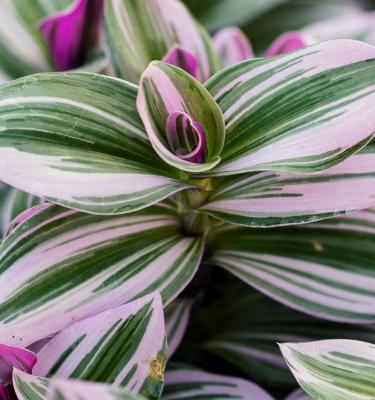

How to grow Tradescantia
Spiderwort (Tradescantia zebrina) is an easy-to-grow, trailing plant with multi-coloured green/purple leaves for real wow factor! There are lots of other species of Tradescantia also available too - some with pink/green or green/white leaves and others with pink/purple leaves.
Spiderworts prefer a spot with bright, indirect sunlight - too much direct sun can cause their leaves to burn. Given their trailing growth habits of many species, they look amazing in hanging baskets.
Tradescantia species are so easy to grow that in many areas they are considered a weed when grown outdoors, so with this in mind please keep yours as an indoor plant unless you know it isn’t a declared weed in your area.
Top 5 steps to growing Spiderwort
- Spiderwort or Tradescantia plants prefer a spot with bright indirect light - direct sun can burn their leaves.
- Use a premium potting mix, like Scotts Osmocote Controlled Release Fertiliser for Indoor Plants to give your plant the best start possible
- Spiderwort like a moist, but free draining soil - water them when the top 2-3cm of the soil feels dry. Make sure the pot has drainage holes and don’t allow water to collect in saucers or the base of cover pots. Excess water can cause the leaves of your Spiderwort to turn yellow.
- Fertilise Spiderworts with an indoor plant fertiliser like Scotts Osmocote Pour+Feed for Indoor Plants once a month during spring and summer, to encourage strong healthy growth.
- Spiderworts are native to tropical and temperate climates around central and south America. If you notice the leaf colours begin to fade, it’s likely your plants are not getting enough light. Try relocating them to a brighter spot.
Shopping List
- A Spiderwort / Tradescantia plant
- A suitable pot
- Scotts Osmocote Premium Indoor Potting Mix
- Scotts Osmocote Controlled Release Fertiliser for Indoor Plants or Scotts Osmocote Pour+Feed for Indoor Plants
- A potting mix scoop or garden trowel
- Defender Pyrethrum Insect Spray
Growing in a pot
Choose a pot for your Spiderwort that’s roughly 2 times the size of the original nursery pot - make sure it has drainage holes or use a black plastic pot that sits snugly inside a cover-pot or cache pot (pot with no holes).
Half fill your pot with Scotts Osmocote Premium Indoor Potting Mix and gently remove the Spiderwort from the nursery pot and position it into the potting mix, backfill around root ball with more potting mix so that the potting mix is level with, or slightly below, the top of the pot.
Water your new Spiderwort in a well and tip out any excess water from the base of the cover-pot or saucer (if using). Spiderworts prefer to be watered when the top 2-3cm of the potting mix is dry to the touch. Never let water pool in the base of cover-pots or in saucers as your Spiderwort will quickly rot if their potting mix remains soggy or waterlogged.
Fertilising & Care
Fertilise Spiderworts fortnightly in spring and summer with an indoor plant fertiliser to encourage new growth. Use Scotts Osmocote Pour+Feed for Indoor Plants - this is a simple to use ‘measure and pour’ feed which contains the right balance of nutrients. If you’d prefer a longer term fertilising product, with less applications, apply Scotts Osmocote Controlled Release Fertiliser for Indoor Plants in early spring and again in early autumn - this product feeds for up to 6 months.
In the warmer months of spring and summer Spiderworts will appreciate a more regular watering and a higher humidity. To increase the humidity around Spiderworts, group them with other plants to create a microclimate. You can also sit their pot on a saucer filled with pebbles and water - as the water evaporates it will humidify the air.
Remove any dead or damaged leaves to promote new growth. If your Spiderwort grows long and leggy, try moving it to a spot with more bright (indirect) light and prune back leggy growth to encourage a bushier plant. Any cuttings can be quickly rooted by poking the cut end into a small pot filled with potting mix.
To remove the dust that collects on Spiderwort leaves, pop it into the shower or bring it outside for a gentle hose off or use a soft, damp cloth to remove stubborn dust gently.
Pests & Diseases
Keep an eye out for scale, mites and mealybugs attacking your Spiderwort plants - regularly check the backs of the leaves and the leaf/stem joins for signs of these pests - use Defender Pyrethrum Insect Spray to control them if needed.
Browning leaves on your Spiderwort could indicate too much fertiliser or not enough humidity around the plant. If the colour or leaf variation fades, it’s a sign your Spiderwort is not getting enough bright light.
WARNING - Spiderworts are mildly toxic to pets and children. Keep them away from both.



